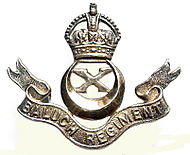10th Baluch Regiment
| 10th Baluch Regiment | |
|---|---|
 |
|
| Active | 1922–1956 |
| Allegiance |
|
| Branch |
|
| Type | Infantry |
| Regimental Centre | Karachi |
| Uniform | Rifle Green; faced red |
| War Cry | Kai Kai |
| Engagements | Expedition to Aden 1839 Anglo-Persian War 1856-57 Indian Rebellion of 1857 Taiping Rebellion 1860-64 Abyssinian Campaign 1868 Second Afghan War 1878-80 Anglo-Egyptian War 1882 Third Burma War 1885-87 British East Africa 1896 British East Africa 1897-99 The Boxer Rebellion 1900 British Somaliland 1908-10 First World War 1914-18 Third Afghan War 1919 Iraqi Revolt 1920 Burmese Rebellion 1931-32 Second World War 1939-45 Kashmir War 1948 |
| Commanders | |
| Colonel-in-Chief | King George V |
The 10th Baluch or Baluch Regiment was a regiment of the British Indian Army from 1922 to 1947. After the independence, it was transferred to the Pakistan Army. In 1956, it was amalgamated with the 8th Punjab and Bahawalpur Regiments. During more than a hundred years of military service, the 10th Baluch Regiment acquired an enviable reputation as one of the most distinguished among the fabled regiments of the British Indian Army. Its long list of honours and awards includes four Victoria Crosses.
The Baluch Regiment originated in the Army of Bombay Presidency in 1844, when Sir Charles Napier raised the 1st Belooch (old spelling of Baluch) Battalion (raised as the Scinde Beloochee Corps and designated as 27th Regiment of Bombay Native Infantry in 1861) for local service in the newly conquered province of Sindh. Two years later, another Belooch battalion was raised (designated as the 29th Regiment of Bombay Native Infantry in 1861), while in 1858, John Jacob raised Jacob's Rifles (30th Regiment of Bombay Native Infantry), which would soon become the 3rd Belooch Regiment. The term 'local' was interpreted fairly loosely when it became necessary to send the 2nd Beloochees to the Persian War in 1856-57, a campaign frequently overshadowed by the events of the Indian Mutiny in 1857. The 1st was in Karachi when the news of the insurrection reached the Commissioner. Sir Bartle Frere dispatched them with all haste, on foot across the Sindh desert in May, to join the siege artillery train on its way to Delhi; the only Bombay unit to join the Delhi Field Force. The regiment was brought into line for its services in North India as the 27th Regiment of Bombay Native Infantry. Meanwhile, the 2nd Beloochees were also regularized as the 29th Regiment. In 1862, the 2nd Beloochees were dispatched to China to suppress the Taiping Rebellion. Two years later, they became some of the first foreign troops to be stationed in Japan, when two companies were sent to Yokohama as a part of the garrison guarding the British legation. The 1st Beloochees greatly distinguished themselves in the tough Abyssinian Campaign of 1868 and were made Light Infantry as a reward. All Baloch battalions took part in the Second Afghan War of 1878-80, where the Jacob's Rifles suffered heavy casualties at the Battle of Maiwand. The 1st Belooch Regiment again distinguished itself in 1885-87 during the Third Burma War.
...
Wikipedia
